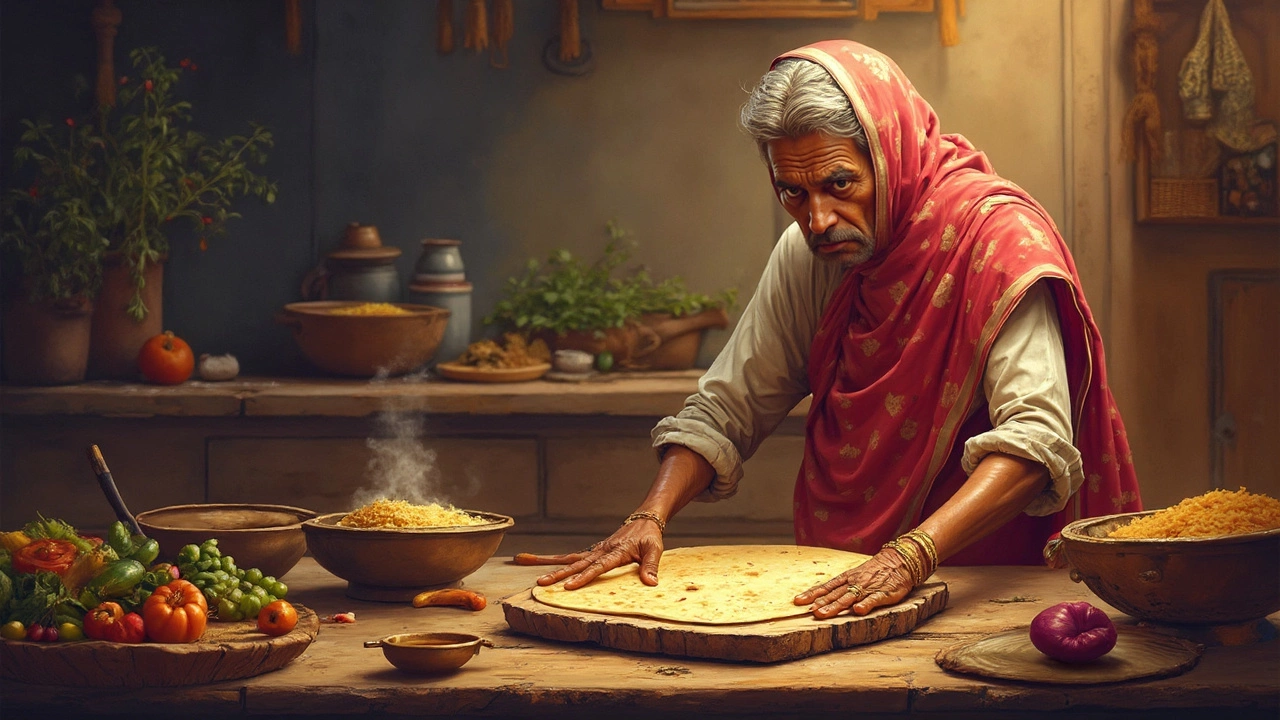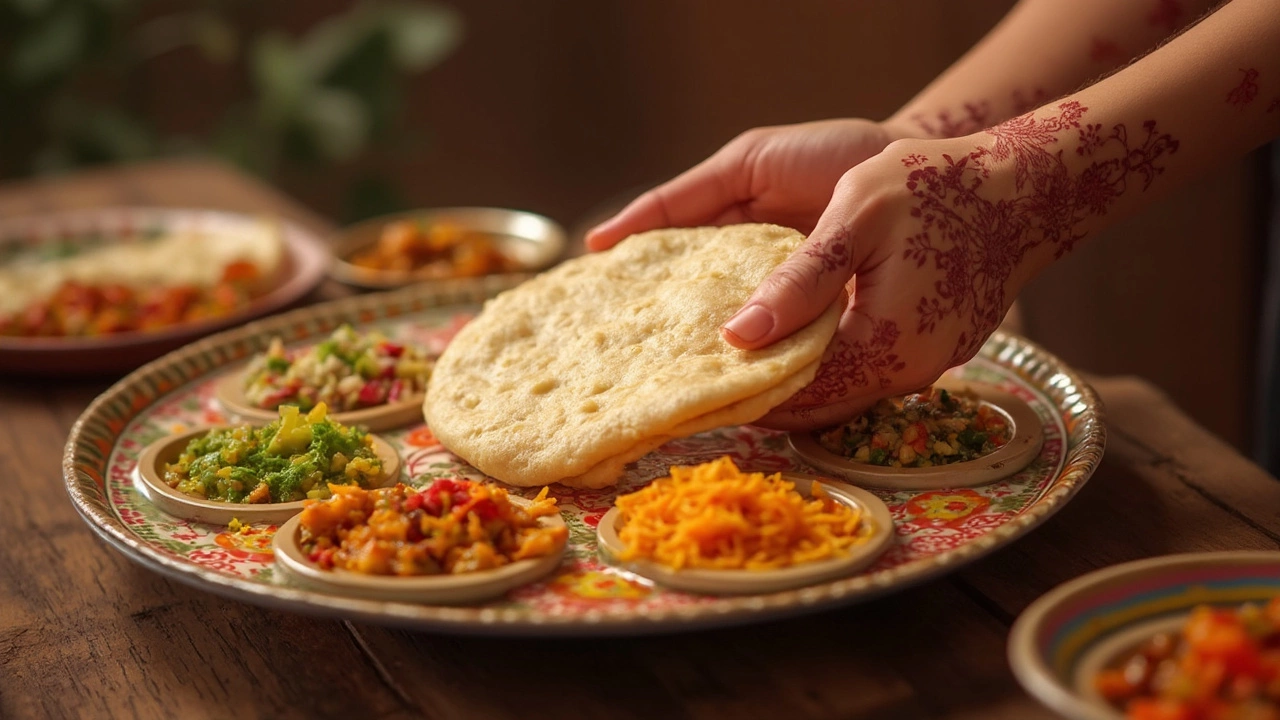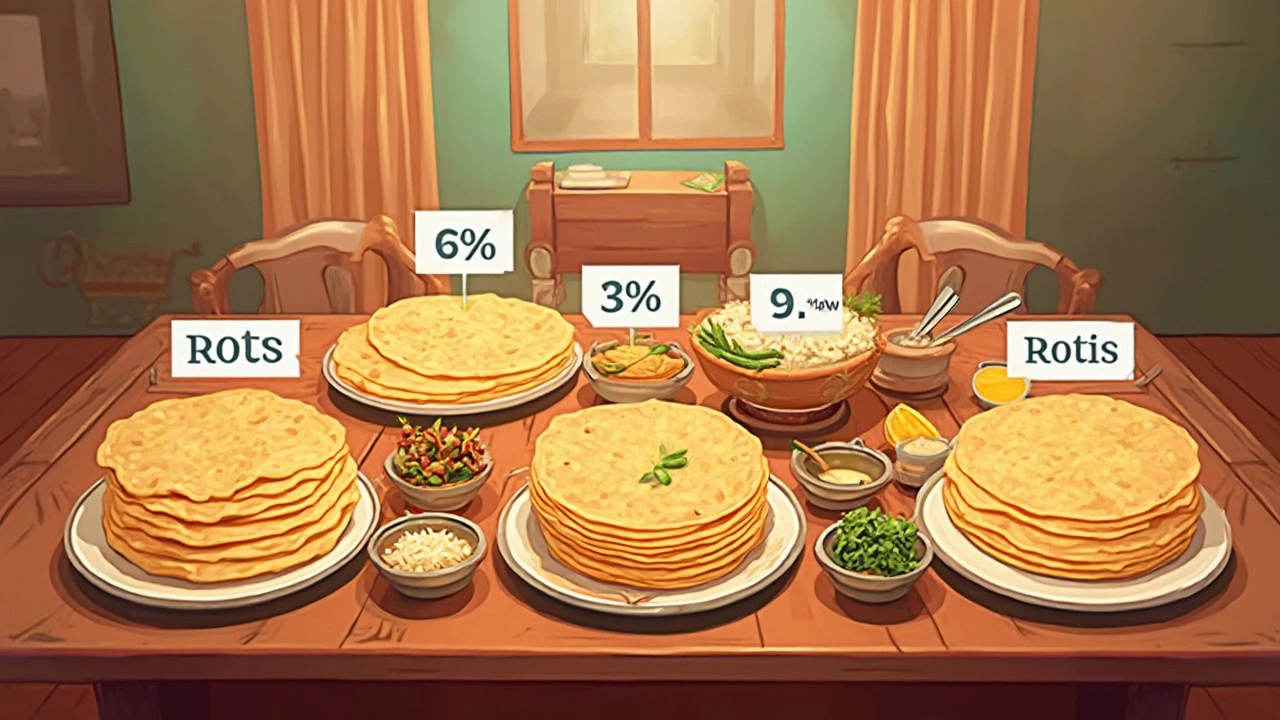How Many Calories Are in 1 Roti? A Complete Breakdown
 Feb, 23 2025
Feb, 23 2025
Ever wondered how many calories are in 1 roti? You're not alone! For those of us who enjoy this versatile flatbread, knowing the calorie count can make a big difference in managing daily nutritional intake. A standard whole wheat roti, roughly around 40 grams, typically packs about 70 to 80 calories. Simple, right? But it gets a bit more interesting.
The calorie count isn't a one-size-fits-all. It can change based on several factors. First off, the flour used matters. Whole wheat is popular for its health benefits and slightly lower calorie profile compared to refined flour. And of course, the size and thickness of the roti can push those numbers up.
And what happens when you add ghee to the mix? Many love that extra richness, but adding a teaspoon of ghee can add around 45 additional calories, making your roti more indulgent. So, if you're wondering about how much calories in 1 roti with ghee, count on roughly 115 to 125 calories in total.
- Understanding the Basic Caloric Content of Roti
- Factors Influencing Roti's Caloric Value
- Roti with Ghee: How It Affects Calorie Count
- Pairing Roti with Sabzi: Nutritional Insights
- Tips to Maintain a Balanced Diet with Roti
Understanding the Basic Caloric Content of Roti
Understanding how many calories in 1 roti is crucial for those trying to manage their diet while enjoying this staple. A regular whole wheat roti, unpacked with extras, offers about 70 to 80 calories. This is assuming a standard size of around 40 grams, something similar to the roti found in most Indian households.
Now, why does this matter? Well, if you're counting calories to maintain, lose, or even gain weight, starting with your daily roti intake is a practical step. The calorie count in a roti largely comes from carbohydrates, with some protein and a tiny amount of fat.
The Flour Factor
Not all rotis are created equal. Using whole wheat flour not only keeps the calorie count in check but also adds fiber, which is great for digestion. If you switch to refined flour, expect a minor calorie hike and loss of the fiber benefits.
Consistency and Size Matter
It's easy to ignore, but the thickness and diameter of roti can affect the calorie count substantially. A thicker, larger roti means more flour, which means more calories. It's that simple.
Plain vs. Ghee
Love adding ghee to your roti? While it tastes delightful, it can add up quickly in terms of calories—around 45 more per teaspoon! If you're trying to cut down, this is one area to consider scaling back.
| Type of Roti | Calories |
|---|---|
| Plain Whole Wheat Roti (40g) | 70-80 |
| Roti with 1 tsp Ghee | 115-125 |
So, if you're wondering about how much calories in 1 roti, it's all about the details. Stick to a standard size for easier tracking. If weight management is your goal, knowing these little details can be incredibly helpful.
Factors Influencing Roti's Caloric Value
The number of calories in 1 roti doesn't just depend on its basic ingredients. Several factors can tweak that number, and knowing them can help you keep track of your nutritional intake.
Type of Flour
Let's start with flour. Whole wheat flour is the classic choice for many households because it’s not just healthier but also lower in calories compared to refined flour. On the other hand, adding other types like millet or barley when making roti can alter the caloric intake slightly, often providing more fiber and nutrients.
Size and Thickness
Next is size and thickness. Bigger or thicker rotis will naturally have more calories. A thicker roti might seem more filling, but it's packing in extra calories compared to the regular-sized ones. So keeping an eye on how big or thick you're making those rotis can help manage how much calories in 1 roti you're consuming.
Additional Ingredients
Adding ingredients like ghee, oil, or butter is a common practice for those who prefer a bit of richness. While it does enhance the flavor, every added teaspoon increases the calorie count by around 45 calories. That's something to consider if you're counting calories.
Cooking Method
Another thing many people overlook is the cooking method. Using a tawa and using no or minimal oil keeps the calories in check, whereas cooking methods that involve frying, like for parathas, can increase the calorie content substantially.
Conclusion
So how do you manage all this? To ensure control over your daily intake from 1 roti, consider smaller portions, opting for whole-grain flour, and using healthier cooking methods. Balancing these factors makes it easier to seamlessly incorporate roti into a balanced diet without any surprises on your calorie count.

Roti with Ghee: How It Affects Calorie Count
Adding ghee to your roti is a tasty tradition for many, but it does alter the calories in 1 roti. Ghee, which is clarified butter, adds flavor and moisture, transforming a simple roti into something quite delightful.
A teaspoon of ghee, the usual amount spread on one roti, contains about 45 calories. So, if you're enjoying your roti with this rich addition, it’s adding up. Let's break it down:
- Regular Roti: 70 to 80 calories.
- Roti with Ghee: Approximately 115 to 125 calories.
Now, you might ask, 'Why bother with ghee if it ups the calorie count?' Well, ghee isn’t just about extra calories—it's also about nutrition and flavor. It’s packed with healthy fats and vitamins, supporting everything from digestion to heart health when consumed in moderation.
Should You Skip Ghee?
Moderation is key, folks. If you're trying to cut down on calories, maybe use ghee sparingly, or reserve it for when you need a little treat. But don’t fear it! Here’s how you can enjoy ghee without overdoing the calories:
- Use only a teaspoon for just the right amount of indulgence.
- Try mixing with spices, like cumin or coriander seeds, to boost flavor and cut down quantity.
- Watch what you pair it with, like heavy curries, to avoid calorie overload.
Remember, the goal isn't to deprive yourself but to make informed choices. Need to count precisely? Keep a tally or check on an app to know how much calories in 1 roti with ghee you’re actually consuming. Balance is everything!
Pairing Roti with Sabzi: Nutritional Insights
Pairing roti with sabzi is like tuning into a symphony of flavors while keeping an eye on health. It's a combo loved by many households across India. So, what's happening nutritionally when you make this classic duo your meal? Let's dig in a bit!
First up, let's talk about balance. The beauty of having roti and sabzi is you're getting a mix of carbohydrates and essential nutrients from the veggies. Carbs from roti give you that energy boost, while the sabzi, whether it's spinach, cauliflower, or mixed veggies, supplies fiber, vitamins, and minerals.
Common Nutritional Pairings
Don't just stop at wheat roti. Ever tried it with dal or paneer sabzi? Here’s a fun fact: a bowl of mixed vegetable sabzi can range from 70 to 100 calories depending on how it's cooked, while paneer can add around 150 calories. But choose your sabzi wisely; oil and portions can tip the scales in different ways.
Tips for Healthy Pairing
- Control Portions: It’s easy to overeat, so keep an eye on how much sabzi you serve with your roti.
- Go for Variety: Try colorful veggies. Think bell peppers, tomatoes, and greens.
- Mind the Oil: Cooking methods can significantly change calories in 1 roti and sabzi. Try steaming or sautéing with minimal oil for lower calorie intake.
| Type of Sabzi | Calories per 100g Serving |
|---|---|
| Mixed Vegetables (without oil) | 80 |
| Paneer Curry | 150 |
| Spinach (Palak) | 60 |
Feeling inspired to tweak your calories in 1 roti and sabzi for a healthier meal? Little changes can have a big impact over time, helping you stay fit without missing out on taste!

Tips to Maintain a Balanced Diet with Roti
Roti is a beloved part of many diets, but how can we enjoy it while staying healthy? Here's your guide to balanced eating with roti.
Opt for Whole Wheat
Choosing whole wheat over refined flour is a smart start. Whole wheat roti offers added fiber, which is great for digestion and keeps you feeling full longer. More fiber means you might even avoid that unnecessary snack.
Watch the Portion Size
It's easy to pile on more food when roti is involved, but keep an eye on the number you consume. One or two rotis paired with a generous helping of sabzi can keep energy levels up without overloading on calories.
Add Ghee Moderately
While ghee on roti is delicious, moderation is key. Adding ghee increases the calories, so maybe keep it for special occasions or when you really need a comforting meal. Remember, those little additions can add up!
Pair with a Variety of Sabzis
Pairing your roti with a colorful variety of sabzi not only boosts nutritional value but also keeps meals exciting. Include a mix of veggies like spinach, carrots, and bell peppers for a range of nutrients.
Incorporate Protein
Adding a source of protein like lentils or paneer alongside your roti helps maintain balanced nutrition. This is important for repairing tissues and supporting muscle growth.
Hydration and Balance
Don't forget to stay hydrated. Sometimes thirst is confused with hunger, leading to extra eating.
| Calories in 1 Roti | Benefits |
|---|---|
| 70 - 80 | Main source of carbohydrates |
| Calories in 1 Roti with Ghee | Benefits |
| 115 - 125 | Rich in taste, provides healthy fats |
By keeping these tips in mind, you can enjoy your roti without compromising on nutrition. Balancing your meals is about making mindful choices that fit your lifestyle.